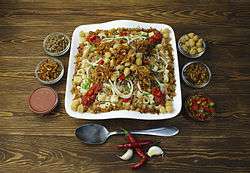Kushari
|
Kushari | |||||||
| Type | Mixed-rice dish | ||||||
|---|---|---|---|---|---|---|---|
| Course | Main course | ||||||
| Place of origin | Egypt | ||||||
| Serving temperature | warm or hot | ||||||
| Main ingredients | rice, lentils, macaroni, tomato sauce, vegetable oil, onions, cumin | ||||||
| Variations | chickpeas, hot sauce, garlic juice, vinegar, short spaghetti | ||||||
| 954 kcal (3994 kJ) | |||||||
| |||||||
| Similar dishes | Khichdi | ||||||
|
| |||||||
Kushari, also koshari (Egyptian Arabic: كشرى, [ˈkoʃæɾi]), is an Egyptian dish originally made in the 19th century, made of rice, macaroni and lentils mixed together, topped with a spiced tomato sauce, and garlic vinegar; garnished with chickpeas and crispy fried onions. A sprinkling of garlic juice, or garlic vinegar, and hot sauce are optional.
History
Kushari originated in the mid 19th century, during a time when Egypt was a multi-cultural country in the middle of an economic boom.
The lower classes' usually limited pantry became full with a myriad of ingredients: lentils, rice, macaroni, chickpeas, tomato sauce, onions, garlic, oil, vinegar, etc. At the end of the month, families would usually have the entire collection of ingredients as leftovers, so families would quickly finish their supply in one dish.
More sources state that the dish originated from India and Italy, in 1914 when Indians attempted to use lentil and rice Khichdi, Italians added macaroni to the dish, over time the dish has progressed and evolved into the current dish through Egyptian soldiers, then Egyptian citizens.[1] Kushari used to be sold on food carts in its early years, and was introduced to restaurants in later years.
Koshari is widely popular among workers and laborers. It may be prepared at home, and is also served at roadside stalls and restaurants all over Egypt; some restaurants specialize in kushari to the exclusion of other dishes, while others feature it as one item among many.[2] As traditionally-prepared kushari does not contain any animal products, it can be considered vegan so long as all frying uses vegetable oil.
See also
Other mixed rice dishes
- Arroz a la valenciana (Spain, Philippines)
- Arroz con Pollo, Arroz con gandules, Gallo Pinto, Pabellón criollo, Platillo Moros y Cristianos, Rice and beans (Latin America)
- Biryani (South Asia, India, Pakistan)
- Fried rice (East Asia)
- Ghapama (Armenia)
- Jambalaya (Louisiana)
- Jollof rice (West Africa)
- Hoppin' John (Southern United States)
- Kabsa (Saudi Arabia)
- Kedgeree (United Kingdom)
- Nasi Goreng (Indonesia)
- Orez Shu'it (Israel)
- Paella (Spain)
- Pilaf/Pulao (Greece, Balkans, Turkey, Iran, Central Asia, Pakistan, South Asia)
- Rice and peas (Caribbean)
- Risotto (Italy)
- Spanish rice (Mexico)
- Takikomi gohan (Japan)
References
- ↑ yahoo- maktoob CNBC
- ↑ "Kushari recipe". Whats4eats.com. Retrieved 2013-02-17.
External links
| Wikibooks Cookbook has a recipe/module on |
-
 Media related to Kushari at Wikimedia Commons
Media related to Kushari at Wikimedia Commons - Egyptian Kushari with step by step photos from Food Lover
- Article on Egyptian vegetarian cooking
- A travel writer's take on Kushari in Cairo
